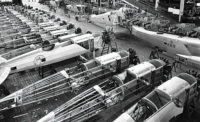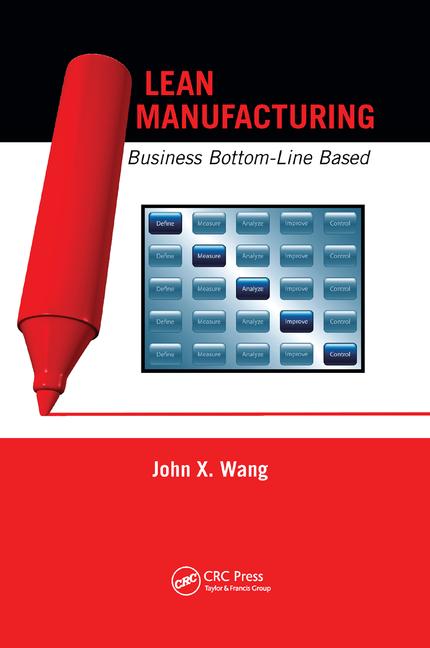
The Boeing 717-200 is a $35 million aircraft designed for the short-haul market, which is characterized by high-frequency, short-range trips that average just over 300 miles in length. The 124-foot long twinjet competes in an extremely price-sensitive market due largely to relatively thin profit margins for small commercial transports and foreign government-sponsored subsidies.
Boeing’s biggest competitor, Airbus Industrie (Toulouse, France), makes a rival plane called the A318, although it is actually a medium-range air-plane and is heavier than the 717. Other regional plane makers, such as Bombardier (Montreal) and Embraer (Sao Paulo, Brazil), are in hot pursuit in the growing market for regional jets.

“In developing the new twinjet, we combined the best features of proven Douglas twinjets with new technology—but only where it produced increased reliability and lower operating costs,” says Jim Phillips, 717 program vice president. For instance, the aircraft’s standard take-off and landing weights were lowered to improve operating economics and flexibility for airlines.
Two Rolls-Royce BR715 high-bypass-ratio engines power the 717. With a range of more than 1,600 statute miles, the aircraft can fly all day with minimal refueling time.
Market Demands
According to Phillips, the short-range airline market demands aircraft with low operating costs and high dispatch reliability. For instance, the typical customer would require each plane it orders to make eight to 12 flights every day. “The 717’s exceptionally low trip cost allows operators to explore new markets with lower risk,” adds Phillips.Numerous features make the 717 attractive to airlines, such as advanced avionics technology, low noise and emissions, low maintenance costs and significant savings in fuel. A key feature of the plane is its airport efficiency. The 717 is designed for quick turnaround without jetways or ground support equipment. For instance, its cargo doors and refueling stations can be accessed without ladders, steps or service platforms.
Airlines with large fleets of Boeing 717s include AirTran Airways and Trans World Airlines (a subsidiary of American Airlines). Midwest Express recently signed an agreement with the intention of acquiring up to 50 aircraft.
Phillips claims the 717 is positioned in the heart of the 90- to 110-seat regional market, which is projected to require 3,000 airplanes during the next 20 years. Factors contributing to that demand include airlines and leasing companies that will be replacing and expanding their fleets; stricter environmental regulations; and passenger preference for high-frequency jet service, especially in markets served by slower turboprop aircraft.
The 717 is one of the most globally sourced planes in the Boeing fleet. Major sections of the plane are built around the world and shipped to Long Beach for final assembly.
For instance, the fuselage is built by Alenia (Rome, Italy); the wing is made in Canada by Boeing Ltd. (Toronto); the landing gear is built by Israel Aircraft Industries (Tel Aviv); engines come from Rolls-Royce GmbH (Dahlewitz, Germany); and the empennage is made by Aerospace Industrial Development Corp. (Taichung, Taiwan).
Other parts of the plane are made locally, such as avionics by AlliedSignal (Torrance, CA) and nacelles by Goodrich Corp. (San Diego). Advantages of having a global supply chain include the ability to spread financial risk and gain foreign-market access.
Final assembly of the 717 takes place in Building 80 at Boeing’s Long Beach Div. The 600,000-square-foot building was constructed in 1957 to build the DC-8 passenger jet, and was the first fully air-conditioned facility in the United States. It is famous for a huge “Fly DC Jets” sign on the roof that brightens the nightime sky. Other airplanes that were assembled in the building include the DC-9, MD-80 and MD-90.
The Long Beach Div., formerly the Douglas Aircraft Co., opened in 1941 and has built more than 15,000 military and commercial airplanes. During World War II, Douglas was a “blackout” plant and was camouflaged with paints, patterns, trees and shrubs.
Lean Thinking
Boeing employees spent 2 years working with Japanese consultants from Shingijutsu Co. to learn about lean manufacturing. The system they set up in Long Beach is based on the Global Production System, which is a derivative of the Toyota Production System.According to Aaron Kotyluk, head of flow production and lean manufacturing consultant for the 717 moving line, special emphasis was put on tactics to bal-ance the line, standardize work procedures, put visual controls in place, place parts and tools at the point-of-use and establish feeder lines. Successful adoption of each of those lean production tactics were critical steps toward reaching the ultimate goal, which the plant expects to implement next month: conversion to a continuously moving assembly line.
Balancing the line essentially means evenly distributing both the quantity and variety of work across available work time, avoiding overburden and underuse of resources. This eliminates bottlenecks and downtime, which translates into shorter flow time.
Standard work procedures are the foundation of the lean production system at Boeing. “A standard operation is a known, repeatable process that results in high-quality output,” says Kotyluk. It ensures that everyone does the same job in the same way, in the best way possible. “Having reliable, consistent processes in place can help employees eliminate the non value-added activities,” notes Kotyluk.
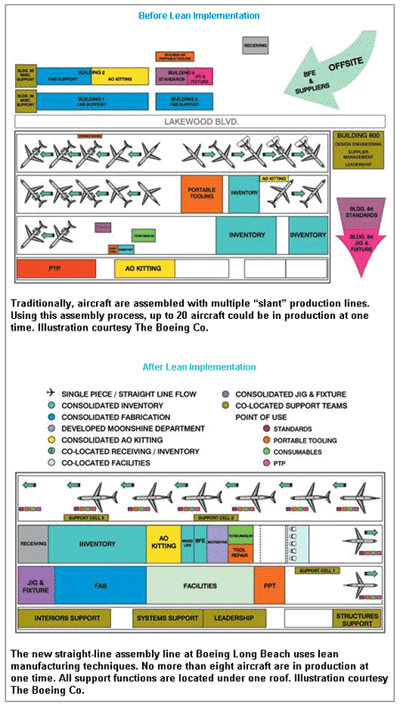
Point of use is a technique that ensures people have exactly what they need to do their job—the right information, parts, tools and equipment—where and when they need them. According to Kotyluk, having parts, tools, equipment and work instructions delivered to the point of use saves time, eliminates wasted movement and wasted space, and ensures that the time spent on products and processes adds value to the final product.
Feeder lines allow assemblers to perform preassembly tasks off the main production line. For instance, traditionally when wings come into a final assembly area, inboard and outboard flaps are installed onto the wing after the wing is attached to the fuselage.
However, a wing feeder line would allow flaps to be attached to the wing before arriving at the final assembly area. When the feeder line is implemented, the wings will arrive when assemblers are ready to attach them to the fuselage. “Performing certain processes off the main production line means fewer parts in the main assembly area, the availability of service-ready components and assemblies in the main production area, and improved quality and less lead time to build a product,” says Koytluk.
Lean manufacturing at Boeing focuses on three basic principles: Takt-paced production, one-piece flow and pull production.
Takt-paced production describes the rate of assembly in a factory. Lean does not mean doing things faster; it means doing things at the right pace. Essentially, the customer’s rate of demand establishes the pace, or takt time. So, rather than simply maximizing the rate of the work, lean production sets the pace in the factory, ensuring that the customer’s needs are met on time.
One-piece flow is the opposite of batch production. Instead of building many products and then holding them in queue for the next step in the process, products go through each step in the process one at a time, without interruption. Producing products one at a time continuously improves quality and lowers costs.
Pull production is the opposite of push. It means products are made only when the customer has requested or “pulled” it, and not before. Doing so prevents building products that are not needed. After achieving a predictable pace of production, one-piece flow and reliable machinery, a company can operate in a pull production environment, allowing it to assemble products when customers need them.
“The biggest challenge so far is changing from a push production system to a pull production system,” says Kotyluk. “Push production is based solely on schedule. Pull production is based on customer requirements.”
Traditionally, airplanes are assembled in a “garage-style” format with multiple “slant” production lines. “Garage-style plant layout is when the product starts in one spot and stays there throughout the entire build process,” explains Kotyluk. “With garage-style production, no one can tell what the health of the line is. Because there is no product movement to act as a pacemaker, you can’t tell at a glance if you are meeting customer requirements or not.
“There is no flow with garage-style production,” adds Kotyluk. “Parts have to travel all over the place instead of traveling to the same spot every time.”
With the garage-style assembly line at Boeing Long Beach, up to 20 aircraft were in production at one time. The new, straight-line approach reduces that number, with an assembly line that accommodates only six planes.

A Long, Lean Line
The lean manufacturing initiative at Boeing Long Beach was divided into three different phases. The final phase, a continuously moving assembly line, will be implemented next month.Phase One, completed in April 2000, consisted of the installation of chain drives and tooling rails. After the west half of the factory was cordoned off, construction workers began ripping up the floor. They dug a 3-foot-deep trench that was 25 feet wide and 1,100 feet long.
A new floor was installed to accommodate the size and weight of six 717 airplanes stretched nose-to-tail. The 124-foot-long aircraft has a 93-foot wingspan and weighs 94,000 pounds. More than 250,000 pounds of rebar was installed under the floor to support the weight of the aircraft and the tooling.
Two sets of parallel guide rails were inset into the concrete floor. The inboard rails are 5 feet from the center of the line, while the outboard rails are 10.5 feet away.

A 25-horsepower electric motor that drives the chains is buried under one end of the assembly line. “The motor runs through a very complex set of gears that transfer the speed of the small motor into the necessary torque,” says Kotyluk.
The new assembly line is 1,148 feet long and 50 feet wide. The entire construction project took 5 months to complete. With recessed rails and parallel cable slots, the floor of the assembly line bears a strong resemblance to Powell St. in San Francisco and its cable car tracks.
Pulsed Mode
Phase two of the project, completed last November, involved rolling airplanes in a “pulsed” mode down the straight line. Each plane is supported by four elevated cradle structures attached to the parallel guide rails in the floor of the assembly line. The wheeled cradles and platform stands are jacked up and then attached to the underside of the plane by pins. The largest workstand, located at the rear of each plane, consists of three work platforms arranged at different heights.Existing cradles and platforms were retrofitted with guide pins that are aligned with the chain drive under the floor. A manually operated crank on the cradle lowers the pin and inserts it between two lengths of chain. When the chain is activated, it pulls the aircraft and workstands down the line simultaneously.
An electrical power cart positioned under the middle of the fuselage is also attached to the chain-drive system. It provides electrical and pneumatic power for tools, in addition to water hookups. The water is used to test seals for leaks while the plane is moving down the assembly line.
“We had to design the power cart to pull electricity from the underground bus-bar, and purchase state-of-the-art air compressors,” says Kotyluk. “Other than that, and the redesign of the forward entrance stands (to accommodate the power cart and air compressor), we have been able to use all our regular tools. We were able to modify 80 percent of our existing equipment.”
At the push of a button, all six airplanes on the assembly line move 160 feet simultaneously. Because this operation takes minutes instead of hours, it adds up to significant time savings.
In the past, the process of moving airplanes required workers to remove all workstands, fixtures, tools, air hoses and parts bins. Then, a tow-bar was attached to the forward landing gear and a tug maneuvered each plane into its new position. Workstands, fixtures, tools, air hoses and parts bins were then moved back into position.
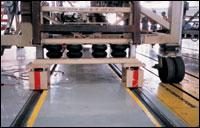
“A pulse line only moves every few days,” explains Kotyluk. “We set the line at 10 feet per minute and move the aircraft for close to 18 minutes. This allows the aircraft to pulse into their next position.
“Work does not continue or move to the next assembly position until detected problems are corrected and all work assigned to that position is complete,” adds Kotyluk. “Reliable processes are put in place to respond to potential problems or immediate problems to keep work moving or to quickly resume after work has stopped. Garage-style production does not have an apparent flow or any of the above attributes.”

A Moving Experience
The final step in the lean manufacturing project at Boeing Long Beach is conversion to a continuously moving assembly line. “We expect to begin moving the entire line in September,” says Kotyluk.The line will be moving at just over 0.5 inch per minute. “We got that number by taking into account the length of the building, quantity of aircraft in the line at one time and the production rate,” explains Kotyluk. The line will move approximately 18 feet per shift for two shifts and will stop only when a problem is detected. It will move on first and second shift only.
“Moving production lines ensure that value is added as long as the product moves continuously through production, eliminating enormous costs,” says Kotyluk. The new production process, the only one of its kind in the world, is expected to slash final assembly time by more than 50 percent.
“The biggest benefit may be the sense of urgency a moving line conveys throughout the production process,” says Kotyluk. “Employees can truly see and feel the pace of production.”
The new process has eliminated a lot of non value-added steps. Kotyluk says drawings, parts, tools and work orders are brought in a point-of-use approach to the assemblers, “as if they were surgeons and the airplanes were patients.”
“Kitting” plays a key role. Assemblers are supplied with kits—a box of parts, fittings and tools—for each task they do. This eliminates time-consuming trips from one supply center to another to get the necessary material.
Within only feet of the assembly positions are support teams located in open factory-floor offices. They are equipped with everything necessary to help keep airplanes moving, and include employees who inspect work while it’s being done.
Other resources are nearby, including a quick-response parts fabrication shop and a special team dedicated to meeting rapid equipment requests. This unit is affectionately called the “Moonshine Department.”
“The moonshine shop is where all the creative ideas from the line become reality,” says Kotyluk. “They have been able to rapidly turn around prototype tooling in just a couple of hours so we can continue simulating the moving line without delay. This shop creates all the necessary infrastructure for point-of-use and feeder lines. The shop also creates shop aid templates to assist the mechanics in reducing cycle time.”
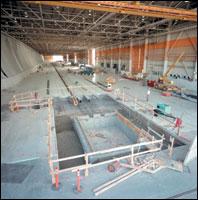
Assembly Process
There are two static join positions and six positions on the moving line. The 717 assembly process begins with installation of wiring, control panels and other components in five nose sections on a short, movable line adjacent to two fixed positions where major aircraft structures are joined. Each nose structure is fabricated by Korean Aerospace (Seoul) and shipped to Long Beach for final assembly.Finished nose sections are moved by overhead crane and attached to the fuselage sections joined at assembly Positions 1 and 2. Wings, empennage and landing gear are also attached at those positions.
From those two points, aircraft are rolled outside the building by a motorized tug and turned around 180 degrees. Once the aircraft is aligned, the wheeled cradles are positioned at the tail, the nose and each side of the wing. The plane is ready to start is journey down the final assembly line.
The moving assembly line has six production positions. Work performed at each of the stops includes:
- Installation of flaps, slats, rudder and horizontal stabilizer occurs at Position 3. The majority of wire runs, hydraulic lines and fuel lines are also attached, plus the deicing system. This position also includes pressure testing.
- Position 4 installs rigging of the flight control systems and the hydraulic system, plus final electrical hook-ups, side walls, drop ceilings and aft lava-tory partitions.
- Position 5 installs stowbins, ceiling panels, pylon fuel systems, door liners and an auxiliary power unit. Wire integrity testing is also conducted.
- Position 6 installs engines, final wing installations, flight deck installations and precut carpet.
- Position 7 installs engine cowl, fan cowl, exterior lighting and carpet. Function tests check radar, communication, navigation and auto flight systems.
- Position 8 installs cockpit and passenger seats. Evacuation slide testing and customer inspections also occur during this final stop.
The biggest challenge with the moving line will be the ability of assemblers to stop the line when an error is detected. This will prevent defects from being passed on to the next step in the production process. Equally critical will be the ability to get the assembly line moving again once a defect has been corrected.
The lessons learned with the new 717 assembly process may soon be applied to other Boeing plants that assemble larger aircraft. According to Kotyluk, the Long Beach experiment has generated a lot of interest within the company.
“All facilities, not just commercial airplanes, have been here to benchmark our progress and begin the same journey toward waste elimination,” Kotyluk points out. For instance, engineers at Boeing’s 737 and 757 plant in Renton, WA, have been conducting simulations with different types of movement mechanisms and kitting exercises.

